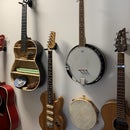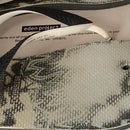Introduction: Songwriting and Composing Tool - Interactive Circle of Fifths
Sometimes when songwriting we get stuck in little ruts. We sit and strum the guitar from G to C and back again for hours on end while thinking of the words that we want to write and when we get there, we end up writing another song that sounds the same as the last one we wrote.
So we endlessly play the same patterns over and over until the below example happens.
Axis of Awesome
So how do we get outside of our familiar and write something truly original or interesting without just getting weird? The Interactive Circle of Fifths is a super handy tool for this. What about transposing a song on the fly when the guitarist puts on a capo and annoys the keyboard player? Using the Interactive Circle of Fifths is a great way to train you to do this.
How does it work?
Well... depends how you want to use it, but here is an easy example.
In the Major Ionian key of C (all the white notes on a piano), there are no sharps and no flats (black notes).
In order to play in the key of C, you can (mostly) only play 7 different notes before they repeat again.
There are only 7 combinations or chords that can be made in combinations of 1,3 and 5. Three of these chords have a major third, four have a minor third and one also has a flat 5 or diminished 5. (Have I lost you yet?) Well, the chords in the key of C major are C, Dm, Em, F, G, Am, Bdim.
You might remember that fairly well, but how to remember which are majors or minors? Well... dial the Interactive Circle of Fifths to put C as the root note and follow the color codes. The chord each side of the C will be yellow which indicates a major chord, the chords in blue are the minor chords and the green one is diminished.
How to get creative with it:
What if you wanted to take a pop song and put a completely different feel to it without losing the song entirely?
Well, you don't have to play it in a major mode. There are other modes that can be played. You could dial the Interactive Circle of Fifths one to the right and play the song in Mixolydian... don't like it? Dial it again, try a new one. Write the notes using the numbering system ie. in the major C scale C=I, Dm=ii, Em =iii, F=IV, G=V, Am = vi, Bdim = vii.
Then as you dial the Interactive Circle of Fifths, you will notice that some of the chords drop out, but the numbers become a different chord. For example, in C mixolydian scale, Bdim drops out and becomes Bb. Other chords might usually be played as a major chord, but now are played as minors. This changes the feel of the song.
Here's another cool thing, it doesn't just work for chords, but also for scales. You work your way from the root note, counting every second note you jump back to the top and coming back down again. So you can use it to learn your scales for guitar, keys, etc.
One more before we move on. What happens if you don't follow the rules? Say you play a whole song in a very normal scale, but you just decide to borrow a few chords from other scales?
I would suggest looking up the chords to the song Hotel California and trying to work out what scale or mode it is in. They very skillfully borrow a number of chords that shouldn't be there, but it beautifully creates the tension and memorable pattern that we all are familiar with. So? Be brave... start with a 5th of the 4th in the major scale... Try dropping it in and see what happens. Maybe create tension by switching a chord between being minor to being major.
For more ideas on how the circle of fifths work, check out this video by Michael New or this video by Mark Newman.
is also helpful.
Check out the next steps to find out how to build your own in an afternoon.
Also, keep an eye out on my page because I'll be making a few cool musical theory tools over the next wee while. (Mostly because I want to learn some more theory).
Step 1: Building It
Step 1: Print out the PDF file in the link.
The Base Layer and Layer 2 should be printed on paper. If you are wanting to make a wooden one like mine and transfer it to the wood, you will need to print it on a printer that uses toner, like a big photocopier. You will also need to print the included reversed copies as transferring it to wood will give you a mirror image.
Alternatively, you could print this out at home and stick it on to cardboard.
Layer 3 needs to be printed on a transparency. These can be difficult to find now that overhead projectors are no longer a popular thing.
I would recommend laminating all of the sheets for durability, but again, that is optional. Once you have printed it all out, cut everything out.
I've included the Inkscape SVG file so that you can download it and make any changes that you would like to make. You could rework it so that you don't have to use a transparency.
Just a hint... any size alterations will need to be made exactly the same on each piece. If you resize it, check that the letters around the outside still line up. For some reason, this kept playing up for me and it took a lot of playing about.
Step 2: Wood transfers.
(Could be after step 3... I just was just lazy and wanted to use my transfer to decide the size of the wood and I didn't want to cut it out until I knew I got the transfer right.)
I experimented with a heap of techniques including modge podge, but I've found this one to be the simplest.
Sand the wood all smooth to make it easy to transfer to. The smoother the better, deep sanding scratches will make it hard to get the detail into. Light coloured woods are also going to have the highest contrasts and this is recommended.
Hold the picture up to a glass window and use a pencil to outline all the most detailed parts of the sketch. These are the parts that will need the most pressure and checking.
Lay the paper down on the wood with the picture side down. Check that it is positioned where you want.
Tape the paper in place on one side so that it doesn't move, but you can easily lift it up to check progress.
Now here is the trick. You need something hot and flat. The hotter the better. I tried to use an iron. It works, but you have to use more pressure and you have to be careful that in doing a large piece at once, it doesn't stick.
Personally, I found that my wood burning iron had nice flat edges and worked perfectly for this task. A spoon heated with a lighter might also work well.
Rub on the area you want to transfer. Lift the paper and check regularly, it's ok to lightly brown the paper, but if the paper goes black, you may be burning the wood on the other side and you will lose your detail.
Don't forget to also transfer the tiny little centre mark because it's helpful for lining things up in the end.
Step 2: Cut it out and final sand
Pretty self explanatory, you can use a jigsaw, band saw, coping saw... anything that can cut curves (if you want it to curve).
Step 3: Lining up the layers
I've not made the templates 100% perfect. So it pays to experiment a little by rotating the pieces to ensure that you are fixing them together perfectly in the centre. Find the perfect center of each layer. Stack the layers. Push a tack into the middle and then hammer it down.

Participated in the
Woodworking Contest 2017

Participated in the
Build a Tool Contest 2017















